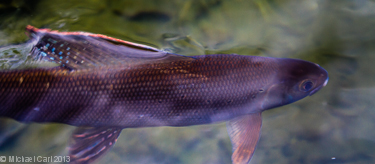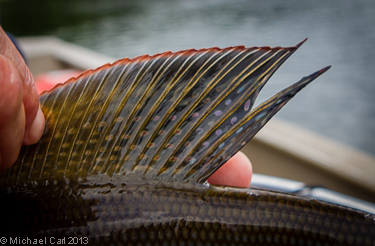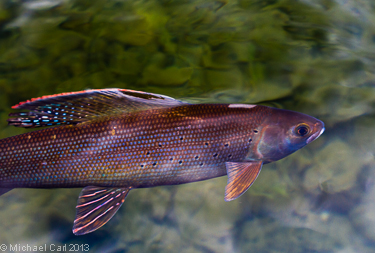Thymallus arcticus
Arctic grayling are found throughout most of Alaska, except southeast, Kodiak Island and the Aleutian islands. They also range from Russia's Ural Mountains across Siberia, Alaska, and Canada to the western Hudson Bay and as far south as Montana in the U.S. and Mongolia in Siberia.
Artic Grayling
The Arctic grayling stands out amongst the freshwater fishes of Alaska - in large part because of its expansive, sail-like dorsal (back) fin and colorful body markings.

The Arctic grayling comes in a wide array of colors. Coloration can vary from stream to stream. Their dorsal fins are typically fringed in red and dotted with large iridescent red, aqua, or purple spots and markings. These colorful markings are most dramatic on large grayling. Arctic graylings. backs are usually dark. Their sides can be black, silver, gold, or blue. A band of gold forms a border between their sides and white bellies, which are in sharp contrast to their pelvic fins striated with iridescent orange, red, or pink.
The sides of the body and head can be freckled with black spots. A black slash lies on each side of the lower jaw. The iris of their eyes is often gold in color. Only their adipose, caudal (tail), pectoral, and anal fins are without much color; typically dull and gray.

Summer Food Fest
During the brief summer, Arctic grayling are voracious feeders. They will eat almost anything that moves, but drifting aquatic insects, especially black flies, mayflies, stone flies, and caddis flies are their primary food items. At times, grayling will gorge upon the eggs of spawning salmon, smaller fish, or terrestrial (land) insects that have fallen into the water. They may even eat an occasional vole or shrew! One grayling had seven shrews in its stomach. Another's stomach contained 65 salmon smolt.

Seasonal Migrations
Arctic grayling have evolved to live in harsh and uncertain environments. Some grayling migrate and take advantage of different streams for spawning, growing up, summer feeding, and overwintering. While other grayling may choose to stay put and complete their entire life in only a short section of a single stream or lake.
In spring, grayling migrate upstream to spawning grounds. Immediately after spawning, adult grayling return to summer feeding areas. The travelling distance can be less than a kilometer or up to 160 kilometers (100 miles.) Some grayling faithfully return every year to the very same spawning and feeding areas.
Arctic grayling of different sizes and ages can be found throughout a whole river system. That said, a discernable pattern of grayling sizes exist from a river's headwaters to its mouth. The older, larger adults tend to lay claim to the cooler upper reaches of a stream system. The sub-adults occupy the middle. Juveniles live in the lower reaches of a river where the warmer water helps speed growth.
Photo of California Golden Trout by P. Michael Carl © The Ecological Angler

